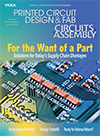Just when the industry thought the shortage saga was over, the parts giant hit refresh on the chaos.
The global electronics industry faces another shortage situation. What began as a governance dispute between the Dutch government and the Chinese ownership of Nexperia has morphed into a geopolitical crisis with wide-ranging impacts on the printed circuit board assembly industry.
The real bottleneck isn’t the layout; it’s decoding those half-hidden specs stuffed into a PDF.
Every electronics engineer and PCB designer knows the feeling: the design is done, the data package is zipped, and the request for quote (RFQ) is sent. And then ... you wait.
This is the quoting “black box.” A project’s momentum comes to a halt, sometimes for days, as you wait for a price. When the quote finally arrives, it might come with design for manufacturability (DfM) queries, unexpected costs or lead times that jeopardize the entire schedule.
How a longtime PCB supplier became a contract manufacturer.
More than a handful of US-based printed circuit board fabricators offer some degree of assembly in order to meet customer demand. Often, these companies are flex circuit manufacturers which add in-house SMT as a strategic advantage so they can offer a one-stop supply model.
Recently, however, a Chicago-area supplier of bare PCBs took a different approach: It acquired, of all things, a full-service EMS company.
Nine critical checks for OEMs to avoiding bottlenecks.
Established OEMs with ambitious growth goals often hit a wall as they expand their product ranges. Internal design and development (D&D) teams become overloaded while juggling updates to legacy products, managing lifecycles and integrating new features. Meanwhile, mounting pressure to innovate and accelerate time-to-market for new products adds to the challenges.
For many, the answer is clear: outsource D&D. But choosing the right partner is anything but straightforward. This is the tipping point. OEMs often need to work fast to choose a D&D partner or face a vicious cycle of competing demands and delays that impact revenue (Figure 1).
Somewhere between the badge scanner beep and missing business cards, community happens.
I’ve been reading to my son before bed lately. And now that we’ve (mercifully) graduated from the picture book phase, I did what any overexcited parent with a bookshelf full of “classics” would do: I went straight for the big ones. Peter Pan. Alice in Wonderland. The Secret Garden.
I quickly realized, somewhere around my third dramatic reading of a particularly dense sentence, that perhaps I was a little too eager. I was narrating stories with words he wasn’t quite ready for yet, piling on adventures that made more sense to me than to him.
Boards aren’t the only things getting more complex. Workloads are too.
PCB designers are, by and large, a veteran crew. Many have been in the game for decades, steadily turning out increasingly complex boards while titles and org charts shift around them.
Press Releases
- Industry Leaders Koh Young, Fuji America, and Creative Electron Unite to Launch The SMT Future Experience
- NanoFlowX Announces Strategic Partnership with Bentec Ltd to Accelerate PCB Protection Innovation Across Europe and India
- Strong signal for the industry: productronica 2025 drives positive industry trend
- Sharpen Your ESD Skills: CE3S Announces Desco’s First ANSI/ESD S20.20 Training Series for 2026


